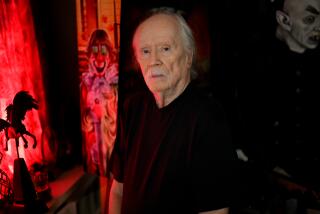Evolution of a Sci-Fi Master
- Share via
Arthur C. Clarke, author of “2001: A Space Odyssey” and numerous other science-fiction hallmarks, rarely does interviews. But he owed us.
On Feb. 3, 1946, The Times ran the first newspaper story about his proposal for communications satellites to bounce radio and TV signals around the world. Although at the time he was almost unknown as a writer and had gained his knowledge of electronics mostly through his work with radar during a stint with the Royal Air Force, his prediction came true with an uncanny degree of accuracy in 1962 with the launch of Telstar. The major flaw in his proposal was that he thought the communications satellites would be space stations with full crews.
“I wrote it before the microchip revolution and the invention of the transistor, when we were still working with bulky equipment and vacuum tubes,” said Clarke, 83, speaking from his home in Colombo, Sri Lanka. “I couldn’t imagine it could become so compact and reliable.
“I’ve often said that the invention of the transistor was a disaster to space travel. Without it, we would be up there by the hundreds.”
The English-born Clarke gave the world one of the most gripping and frightening portrayals of a computer, HAL, an electronic character with a haunting voice that played a key role in the 1968 film adaptation of “2001.” His other works include “Childhood’s End,” “Rendezvous With Rama,” “3001: The Final Odyssey” and the short-story collection “The Nine Billion Names of God.”
COMPUTER: In the 1930s, I was fascinated when I saw [Charles] Babbage’s computer at the Science Museum in London. It was wonderfully exciting.
In the 1960s, I was doing an interview and mentioned that I had just heard about the Hewlett-Packard 9100A, a calculator that had a keyboard like a small typewriter and a three-line display. It was really the forerunner of what we now think of as the desktop computer. Soon after the story appeared I got a letter from Barney Oliver, the famous vice president of engineering at HP, who said, “Arthur, there is a Father Christmas.” A 9100A was on its way to me.
I suppose that’s what I was thinking of when I came up with the HAL 9000 computer. And for 30 years I have been trying to set the story straight about the name HAL coming from IBM with one letter added to each. That was pure coincidence. HAL stands for Heuristic Algorithmic computer.
I think IBM rather liked the idea, though. They later gave me a nice ThinkPad. I wrote “3001” on it.
I’ve since defected to Compaq. I use their LTE 5300 laptop, which is several years old but works fine. I also have a desktop that was assembled locally.
Q: You use both for writing?
A: I don’t much use the laptop except when I get away from Colombo. I have a villa by the sea about 100 kilometers south of here, but I only get there twice a year. It’s difficult for me to get around. [He mostly uses a wheelchair because of post-polio syndrome.]
In any case, I do no writing now. E-mail takes up practically all my time.
Q: You get that much e-mail in a day?
A: Usually about 30 e-mails that I answer. I correspond with a lot of people--after the attacks on New York I was writing to many friends there. My agent saw people jumping out of the building. I think it was a defining moment in history, much like the sinking of the Titanic. In both cases you have a stable, maybe complacent civilization suddenly hit by disasters. There are a lot of parallels, I think.
I wrote this in an e-mail to my friend director Jim Cameron, who happened to be at the Titanic, making dives down to the wreck. He communicated from the Russian ship they were using.
Q: E-mail is an important link for you.
A: I think future historians will wonder how the human race spent its time, before e-mail was invented, during the long, empty ages when there was only television.
HAND-HELD: No, I never got a Palm or any of those. I don’t move around enough for that.
BOOKMARKED SITES: I hardly ever surf on the Web. There are hundreds of Arthur C. Clarke sites, and I never look at them.
GADGETS: I have a glass sphere from Edmund Scientific [https://www.edsci.cohttps://m] that gives out light in all directions like lightning. You put your hand on it and the light goes to it.
Q: That’s an old science fair favorite.
A: I also just ordered a globe of the Earth 10 inches in diameter that floats in midair through magnets. These things amuse the children and visitors, and myself for that matter.
I have a DVD player at the house. The other day, Dan Richtor, who played the ape with the bone in “2001,” was here and I posed him beside the TV set showing that image. [Richtor now does payroll work for entertainment companies]. I labeled the picture: “From ape to L.A. executive in one lifetime. Is this progress?”
Q: Other gadgets?
A: I have one of those stereoscope viewers to view 3-D pictures.
Q: Like a Viewmaster?
A: Yes.
Q: That’s as low-tech as you can go.
A: Very. Nevertheless, you can’t beat the high-quality imagery and colors.
Q: You have a good time.
A: You can quote my epitaph: “He never grew up, but he never stopped growing.”
*
As told to DAVID COLKER
More to Read
Sign up for our Book Club newsletter
Get the latest news, events and more from the Los Angeles Times Book Club, and help us get L.A. reading and talking.
You may occasionally receive promotional content from the Los Angeles Times.







